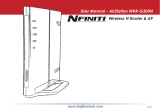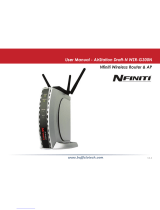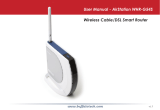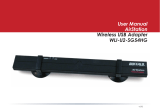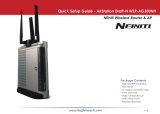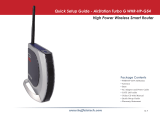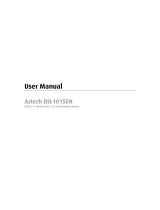Page is loading ...

AirStation
WZR-1750DHP / WZR-1166DHP
User Manual
www.buffalotech.com
35013154-01

2
Contents
Chapter 1 - Setup ...............................................................8
Introduction .........................................................................................8
Diagrams and Layout ...........................................................................8
Front Panel ......................................................................................................8
Back Panel .....................................................................................................10
Bottom ...........................................................................................................12
Right Side ......................................................................................................12
Installation ..........................................................................................13
Vertical Placement ........................................................................................13
Horizontal Placement ...................................................................................13
Wall-Mounting ..............................................................................................14
How to Set Up AirStation for the First Time .....................................15
Connect to a PC and Power On .....................................................................15
Opening Settings ..........................................................................................17
Connect Your Wireless Devices ....................................................................18
Chapter 2 - Settings .........................................................19
Easy Admin .........................................................................................19
Home ..............................................................................................................19
Wireless ..........................................................................................................20
AOSS/WPS......................................................................................................21
USB Storage ...................................................................................................21
Guest Accounts .............................................................................................22
QoS .................................................................................................................22

3
Web Filtering .................................................................................................23
Device Settings .............................................................................................24
Advanced Settings .............................................................................25
Internet ..........................................................................................................25
PPPoE .............................................................................................................26
Dynamic DNS .................................................................................................28
PPTP ...............................................................................................................29
NAT .................................................................................................................30
LAN .................................................................................................................30
DHCP Leases ..................................................................................................31
Routing ..........................................................................................................31
2.4 GHz ...........................................................................................................32
5 GHz ..............................................................................................................34
WPS ................................................................................................................38
AOSS...............................................................................................................39
MAC Filtering .................................................................................................40
Multicast Control ..........................................................................................40
Guest Accounts .............................................................................................41
Wireless Bridge .............................................................................................42
Firewall ..........................................................................................................43
IP Filter ...........................................................................................................44
VPN Passthrough ..........................................................................................44
Port Forwarding ............................................................................................45
DMZ ................................................................................................................46
UPnP ...............................................................................................................46
Web Filtering .................................................................................................47
Access Control ...............................................................................................48
Disk Management .........................................................................................48

4
Sharing ..........................................................................................................50
WebAccess .....................................................................................................51
Media Server .................................................................................................52
BitTorrent ......................................................................................................52
QoS .................................................................................................................53
eco Mode .......................................................................................................54
Network USB .................................................................................................55
System ...........................................................................................................56
Syslog Settings ..............................................................................................57
Reset / Reboot ...............................................................................................58
Update ...........................................................................................................59
System Information ......................................................................................60
Logs ................................................................................................................61
Packets ...........................................................................................................62
Ping ................................................................................................................62
Chapter 3 - Wireless .........................................................63
Wireless Options ................................................................................63
Advanced Wireless Configuration ....................................................64
Manual Configuration (SSID and Password) ...............................................64
Automatic Secure Setup (WPS) ....................................................................64
Automatic Secure Setup (AOSS) ..................................................................65
Adding an AirStation to an Existing Wireless Network as a Client ...........66
Chapter 4 - Utilities ..........................................................67
How to Download Utilities ................................................................67
List of Utilities with Description of Each ..........................................68

5
AirStation Configuration Tool ......................................................................68
Network-USB Navigator ...............................................................................69
Client Manager ..............................................................................................70
AOSS Assistant ..............................................................................................71
WLAN Monitor ...............................................................................................71
Chapter 5 - Troubleshooting ...........................................72
Finding Your AirStation on the Network ..........................................72
Eliminating Dead Spots in Wireless Coverage .................................72
If Your Wireless Connection Is Not Stable .........................................72
Basic Router Troubleshooting ...........................................................72
Basic Router Troubleshooting from a Mac ......................................73
Appendix A - Supplemental Information ......................74
Package Contents ...............................................................................74
Factory Default Settings ....................................................................75
WZR-1750DHP ...............................................................................................75
WZR-1166DHP ...............................................................................................80
Technical Specifications ....................................................................85
WZR-1750DHP ...............................................................................................85
WZR-1166DHP ...............................................................................................87
Shared Folders and USB Ports ...........................................................89
GPL Information .................................................................................90

6
Appendix B - Tutorials .....................................................91
Configuring the AirStation for Optimal Performance and Security 91
Performance ..................................................................................................91
Security ..........................................................................................................91
Sharing a Printer ................................................................................92
Enabling Network USB on the AirStation ...................................................92
Installing and Using Network USB Navigator .............................................92
Configuring the Web Filter ................................................................93
Content Filter ................................................................................................93
Websites Excluded from Filter .....................................................................93
Computers Excluded from Filter ..................................................................94
Finding a Computer’s MAC Address ............................................................94
Configuring Access Control ...............................................................95
Port Forwarding Basics ......................................................................96
Common Uses ................................................................................................96
Security ..........................................................................................................96
UPnP ...............................................................................................................96
Setting Up Port Forwarding Rules ....................................................97
Creating Port Forwarding Rules ..................................................................97
Managing Port Forwarding Rules ................................................................98
Configuring a USB Drive as a NAS .....................................................98
Setting Up the NAS .......................................................................................98
Formatting the Drive ....................................................................................99
User Access ....................................................................................................99
Enable Sharing ........................................................................................... 100
Adding the AirStation to a Wireless Network ............................... 101

7
Set up the AirStation as an Extender ....................................................... 101
Set up the AirStation as a Repeater .......................................................... 102
Saving and Restoring Settings with a Backup File ....................... 104
Save Settings to a Backup File .................................................................. 104
Restoring Settings with a Backup File ...................................................... 105
Replacing the AirStation ........................................................................... 105
Setting Up WebAccess .................................................................... 106
WebAccess Settings ................................................................................... 106
Connecting Wireless Devices Using AOSS ..................................... 107
Pushbutton Method .................................................................................. 107
Setting Up a VPN Server ................................................................. 107
PPTP Settings on the AirStation ............................................................... 107
Editing Users .............................................................................................. 108
Using AirStations with 2Wire Residential Gateways .................... 109
How to Use QoS ............................................................................... 110
Setting a QoS Priority Policy ..................................................................... 110
Manual Entry .............................................................................................. 111
How to configure TCP/IP ................................................................. 112
Windows 8 .................................................................................................. 112
Windows 7 .................................................................................................. 112
Windows Vista ............................................................................................ 113
Windows XP ................................................................................................ 114
Mac OS ........................................................................................................ 114

8
Chapter 1 - Setup
Introduction
Thank you for buying a Buffalo AirStation. The WZR-1750DHP and WZR-1166DHP AirStations are dual-band wireless
routers with outstanding performance and range. They combine high data transfer speeds with a robust set of extra
features like QoS, wireless bridging, USB NAS, media server, and web filtering. This manual will help you set up and
use your new wireless router. If you’re new to wireless networking, turn to chapter 2 to start configuring your wireless
network.
For advanced users, use a wired Ethernet connection to access the AirStation’s settings:
• Default LAN-side IP address: 192.168.11.1
• Username: admin
• Default password: password
Diagrams and Layout
Front Panel

9
1 AOSS button
To initiate AOSS, hold down this button until the wireless LED flashes (about 1 second). Then, push or click the
AOSS button on your wireless client device to complete the connection. Both devices must be powered on for this
to work.
2 Wireless LED
(Access point/wireless bridge control switch set to “AP”)
On:
Wireless LAN is enabled or transmitting.
Double blinks:
AirStation is waiting for an AOSS or WPS security key.
Continuously blinking:
AOSS/WPS error; failed to exchange security keys.
Off:
Wireless LAN is disabled.
(Access point/wireless bridge control switch set to “WB”)
On:
Wireless LAN is enabled or transmitting.
Blinking:
Wireless LAN is enabled but not connected.
Off:
Wireless LAN is disabled.
Note: The wireless LED will be blue for 5 GHz wireless connections or amber for 2.4 GHz wireless connections.
3 Internet access LED (Blue)
On:
Internet access is available.
Off:
Internet access is not available.
Router functionality is disabled.
4 Router LED (Blue)
On:
Router functionality is enabled.
Off:
Router functionality is disabled.
5 Buffalo LED (White or Red)
On (White):
Power is on.
Off:
Power is off.
On (Red)*:
Booting.
2 blinks (Red)**:
Flash ROM error.
3 blinks (Red)**:
Wired Ethernet LAN error.
4 blinks (Red)**:
Wireless LAN error.
5 blinks (Red)***:

10
IP address error.
9 blinks (Red)**:
System error.
Continuously blinking*:
Updating firmware, saving settings, or initializing settings.
* Never unplug the AC adapter while the Buffalo LED is blinking continuously.
** Turn off AirStation, wait for a few seconds, then turn it back on.
*** Because the network addresses of both the Internet port (WAN port) and the LAN port are the same, it is not possible
to establish communication. Change the LAN-side IP address of the AirStation.
Back Panel
1 Access Point/Wireless Bridge Control Switch
This switch changes between access point mode and wireless bridge mode.
AP - access point (or router)
WB - wireless bridge
2 Mode button
If the switch above is in the “AP” position, this button switches the AirStation between router and access point
functionality. If the switch is in the “WB” position, the button has no effect.
3 USB Eject button
To dismount a USB hard drive, hold down this button until the USB LED flashes (about 3 seconds). The USB drive
can then be unplugged safely.

11
4 USB LED (Blue)
On:
A USB drive is connected.
Blinking:
The USB drive can be removed.
Note: When this LED is blinking, the connected USB drive cannot be used. Remove the connected USB drive. If the
LED continues to blink even after the USB drive is removed, restart the AirStation. Do not remove the USB drive or
turn off the AirStation while the USB LED is on.
5 USB 3.0 Port
You can connect any USB 3.0 compatible devices (such as USB storage). Use the cable attached to the USB 3.0
device to connect.
6 USB 2.0 Port
You can connect any USB 2.0 compatible devices (such as USB printers).
7 LAN Port
Connect your computer, hub, or other Ethernet devices to these ports. This switching hub supports 10 Mbps, 100
Mbps, and 1000 Mbps connections.
8 LAN LED (Green)
On:
An Ethernet device is connected.
Blinking:
An Ethernet device is communicating.
9 Internet Port
10 Mbps, 100 Mbps, and 1000 Mbps connections are supported.
Note: In wireless bridge mode or access point mode, the Internet port becomes a regular LAN port, for a total of 5
usable LAN ports.
10 Internet LED (Green)
On:
The Internet port is connected.
Blinking:
The Internet port is transmitting data.
11 Power button
This button turns the power on and off.
It may take 20 to 30 seconds to complete shutdown.
12 DC connector
Connect the included AC adapter here.

12
Bottom
1 Reset button
To reset all settings, hold down this button until the Buffalo LED turns red (about 3 seconds). The power must be
on for this to work.
2 Setup card slot
This is the slot where the AirStation setup card is stored. The initial settings for the username, password, SSID, and
encryption type are provided on the card for logging into Settings .
Right Side
1 Mounting holes
Mounting holes are provided for mounting the AirStation to a wall. Use the supplied screws to mount to a wall.

13
Installation
Vertical Placement
Attach the stand as shown in the figure below.
Horizontal Placement
The same stand also allows horizontal placement. Install the stand as shown in the figure below.

14
Wall-Mounting
Attach to the wall with the supplied screws in the mounting holes as shown below.

15
How to Set Up AirStation for the First Time
Connect to a PC and Power On
To configure your AirStation, follow the procedure below.
1 Verify that you can connect to the internet without the AirStation, then turn off your modem and computer.
2 Unplug the LAN cable which connects your computer and modem.
3 Plug one end of the LAN cable into your modem and the other end to the AirStation’s Internet (WAN) port. Turn on
the modem.

16
4 Turn on the AirStation, then wait one minute.
Note: If the power does not turn on when the AC adapter is connected, press the Power button on the rear of the
AirStation.
5 If using a wired LAN, connect the AirStation LAN port and computer using a LAN cable.
If using a wireless LAN, connect the computer to the wireless LAN as described in Chapter 3.
6 Once your computer has booted, the AirStation’s LEDs should be lit as described below:
Wireless On or blinking
Internet access On
Router On
Buffalo White light on
LAN On or blinking
Internet On or blinking
Note: If the router LED is not lit, hold down the mode button for about 3 seconds to switch to router mode.

17
7 Launch a web browser. If the home screen is displayed, setup is complete.
If username and password fields are displayed, enter “admin” for the username and “password” for the password,
then click Log In. Step through the wizard to complete setup.
You’ve completed the initial setup of your AirStation.
Opening Settings
To configure the AirStation, log in to Settings as shown below.
1 Launch a web browser.
2 Enter the AirStation’s LAN-side IP address in the address field and press the Enter key.
Notes:
• The AirStation’s default LAN-side IP address depends on the mode.
• In router mode: 192.168.11.1
• In access point mode: 192.168.11.100
• In Wireless bridge mode: 192.168.11.100
• If you changed the IP address of the AirStation, then use the new IP address.
3 Enter “admin” for the username and “password”for the password, then click Log In.
Note: If you forget your password, hold down the reset button to initialize all settings. Note that all other settings
will also revert to their default values.

18
4 This is the configuration interface, where most AirStation settings can be configured.
Connect Your Wireless Devices
For each wireless device that you want to connect to the network, use the device’s built-in software to search for
available networks. Find your SSID (the name of your wireless network) on the list of detected networks and select it.
Enter the passphrase for the network and you’ll be connected. Repeat for any additional wireless client devices that you
want to connect.

19
Chapter 2 - Settings
Settings is the configuration GUI for the AirStation. You can configure all settings for the AirStation from here. This user
manual shows examples from the WZR-1750DHP. If you have a WZR-1166DHP, your screens may be slightly different.
Easy Admin
Home
When you first open Settings, the Easy Admin page is shown. From this page you can easily configure common settings.
The examples below assume the AirStation is in router mode.
Wireless Displays current wireless status. Click the panel to configure wireless settings.
AOSS/WPS Displays current AOSS/WPS status. Click the panel to run AOSS/WPS.
USB Storage
Displays the status of USB storage connected to this product. Click the panel to
configure USB storage settings.
Guest Accounts
Displays current guest accounts status. Click the slider to turn guest accounts on or off.
Click the panel to configure guest accounts settings.
QoS
Displays current QoS status. Click the slider to turn QoS on or off. Click the panel to
configure priority control QoS.
Web Filtering Displays current content filter status. Click the panel to configure web filtering.
Device Settings
Displays the number of devices connected to the network. Click the panel to check each
devices status.
Advanced Settings Click the panel to configure advanced settings.

20
Wireless
Configure basic wireless settings here. This mode is available in router and access point mode only.
2.4 GHz (11n/g/b)
5 GHz (11ac/n/a)
You may enable or disable either wireless frequency range independently. If both
wireless radios are disabled, the AirStation will not communicate wirelessly.
SSID 1 Each SSID may contain up to 32 alphanumeric characters.
Encryption
The following types of encryption are available:
WPA2-PSK AES
WPA2 authentication with AES encryption is the best system available. Highly
recommended if all your wireless clients support it.
WPA-PSK AES
WPA authentication with AES encryption is an older system, but still secure.
WPA/WPA2-mixed PSK TKIP+AES
For maximum compatibility, this system allows any combination of WPA, WPA2, TKIP, and
AES. This encryption system works with most older clients but is not very secure.
No Encryption
No encryption means that anyone can log in to your wireless network, snoop on your
wireless traffic, and use your bandwidth. Not recommended for most users.
Encryption Key
The encryption key is like the “password” for your wireless network. It may contain 8 to
63 case-sensitive alphanumeric characters (ASCII) or 64 hexadecimal characters (0-9 and
a-f, not case-sensitive).
Channel
For best results, select Auto Channel. The AirStation will seek and use the clearest
channel automatically. Alternately, you may choose a wireless channel manually.
Bandwidth
In rural areas with little wireless traffic, a larger bandwidth setting may improve wireless
performance significantly. However, if you are in an urban area with much wireless traffic
and interference, the default bandwidth is recommended.
/
